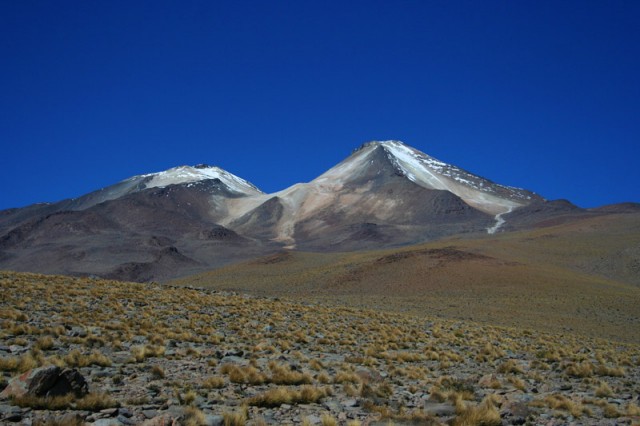
Most of us are familiar with igneous rocks that form in volcanic settings, as lava crystallizes into rock while cooling quickly. It’s easy enough to envision this process since it occurs right before our eyes or at least some cameras (and besides, thousands of science fairs across the country probably display a baking-soda-and-vinegar analog each year).
But what about the igneous rocks that form deep below the surface—like the beautiful granites that are so popular for kitchen countertops? It’s not so easy to imagine how these massive bodies of magma—called “intrusions”—rise through the Earth’s crust before stopping and slowly solidifying, sometimes feeding a volcano at the surface during the process.
Geologists have argued about how this material rises for a long time. Several models have been proposed that would allow this magma to reach its destination; some researchers have proposed a process called “stoping,” where slabs of rock continually fall off the roof of the magma chamber. In this way, the magma could gradually chew its way upwards.
But two other models have garnered greater followings. In one, magma squeezes through fractures to “inflate” a shallow magma chamber. This helps explain a number of observations, including the sheets of igneous rock (formed in those fractures) called “dikes” that are so common in and around these features. The other explanation focuses on blobs of magma known as “diapirs” that force their way upwards through weaknesses in the overlying rocks. Think lava lamp.
In recent years, evidence of dike-fed igneous intrusions has been mounting, but clear evidence of diapirs has been elusive. However, researchers at the University of California San Diego think they’ve caught a diapir in the act in the highlands of the central Andes. They've presented their data in the journal Science.
Beneath this area of the Andes (near the Chile-Argentina-Bolivia border) lies what may be the largest active magma body in the world—a 100 kilometer wide zone almost 20 kilometers beneath the surface. Satellite data had previously measured uplift of the land surface above this zone, and the UC-SD team added another set of satellite observations that allowed for a more precise map of the elevation changes in three dimensions. The results showed that, between 1992 and 2010, there was a circular area of uplift consistently rising at a rate of about 10 millimeters each year. Surrounding that area, however, the researchers discovered that there is also a ring of subsidence, where the land surface is very slightly sinking—resulting in a pattern they compare to a sombrero.
To interpret this finding, the team used computer models to simulate possible configurations of magma activity that could cause this pattern of surface deformation. They found that the best fit to the observations came from simulating a diapir rising from the massive magma body 20 kilometers down. The rising blob is responsible for the uplift in the center (the dome of the sombrero), and the slight deflation of the deeper, wider magma source results in subsidence around the outside (the brim of the sombrero).
The sombrero geometry can’t readily be explained by a dike-fed intrusion, and the steady rate of surface deformation over a period of at least 18 years better fits a diapir, as well. Injection of magma via dikes is understood to be a shorter-term, episodic process.
Looking for similar behavior in other areas will allow researchers to see if this is common or an exception to the rule. The paper mentions one location specifically—the Socorro Magma Body in New Mexico—as a candidate where they think the same “sombrero” pattern of surface deformation might be occurring. Further study of these areas might force the Earth to give up a few more secrets and provide geologists with a better understanding of the igneous action beneath our feet.
Science, 2012. DOI: 10.1126/science.1226358 (About DOIs).
reader comments
18